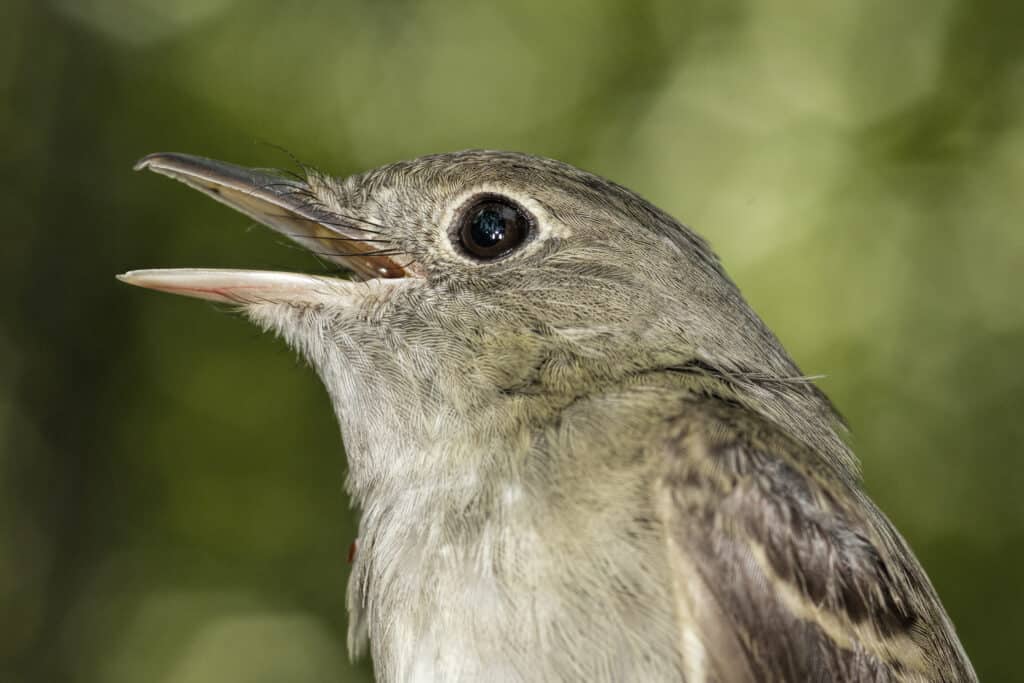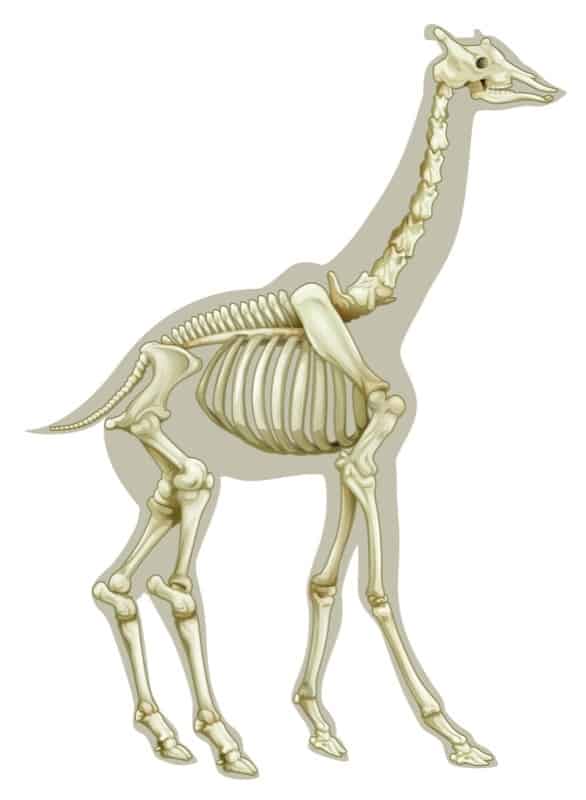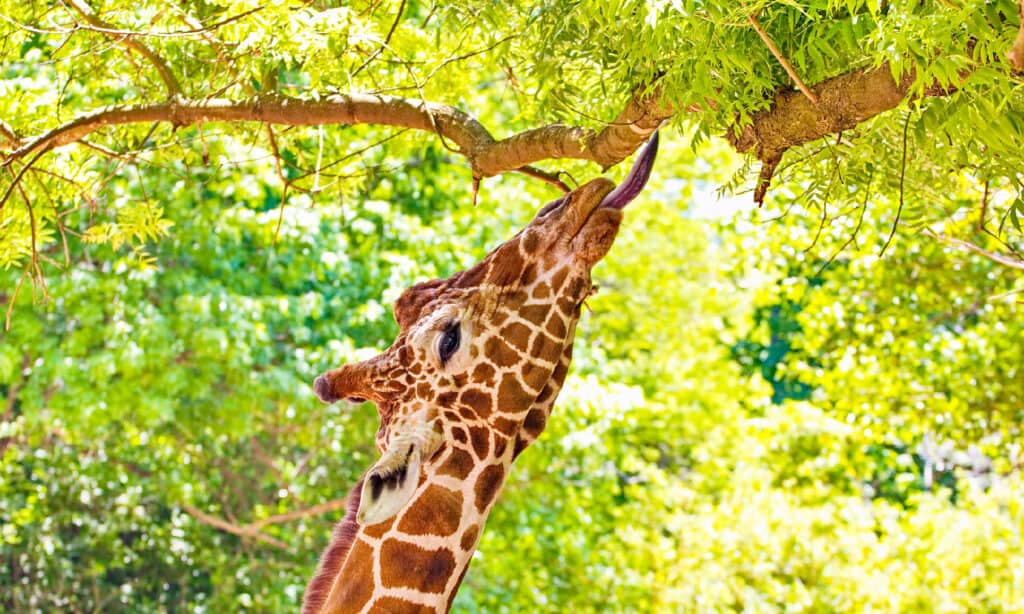It seems incredible, but it’s the truth. Birds have more vertebrae than a giraffe!
Giraffes are a species of animal famous for their long necks and incredible height. There are nine subspecies of giraffes that separated into individual groups around two million years ago.
Their long necks help giraffes to be the tallest extant land mammal on earth. It would make sense that they’d have more vertebrae in their necks than little birds but they don’t. Incredibly, birds have more vertebrae than a giraffe!
What Are Vertebrae?

The vertebrae of a snake.
©iStock.com/Baramee Temboonkiat
Vertebrae are the bones that comprise a backbone. A vertebrate is an animal with a backbone. Both birds and giraffes are vertebrates.
Vertebrae are connected together into a flexible string of bones called the spine. The exact size, placement, and shape of vertebrae vary depending on the needs of a species. Each vertebra is specifically designed to align with the other vertebrae so nerves and the spinal cord run through it.
There are three general vertebrae sections. The cervical vertebrae make up the neck. Thoracic vertebrae occupy the upper body and lumbar vertebrae are part of the abdomen.
The pelvis is part of the sacral vertebrae and the tail is the caudal vertebrae. Birds have a wide range of vertebrae depending on the species while giraffes average fewer total backbones.
Why Do Birds Have More Vertebrae Than a Giraffe?

Because their eyes don’t move in their sockets, birds require a greater range of neck movement than giraffes.
©Bonnie Taylor Barrie/Shutterstock.com
Birds have more neck vertebrae than a giraffe because birds need to turn their head more to see and clean themselves. The bodies of giraffes and birds evolved separately because these animals have separate lifestyles. They interact with their environments differently than each other which requires their unique specialization.
Birds need more neck vertebrae than a giraffe because their eyes don’t move in their eye socket. This means they need to be able to turn their head almost all the way around to spot dangers behind them.
Birds with dramatically elongated necks, like ostriches and emus, have more vertebrae than other birds to accommodate their neck length. Birds also have less dense bones which aid in flight by reducing their overall weight.
The neck of giraffes is designed to snag high-growing plants and to create a unique vantage point so they spot predators more easily. Giraffes see in color and have a huge range of vision and they’re also able to move their eyeballs in their sockets. As a result, they don’t need to move their heads as much and don’t require more vertebrae.
Birds also use their bills to preen and grab precariously placed food items. This demands flexibility that more neck vertebrae accommodate.
Giraffes don’t bathe themselves as they rely on body oil and birds to keep their skin healthy. This means that they don’t need to reach their backs to clean themselves.
How Many Vertebrae Do Giraffes Have?

Giraffes have seven neck vertebrae.
©BlueRingMedia/Shutterstock.com
Giraffes, like almost all mammals, have seven neck vertebrae. They probably have around 50 vertebrae in total.
Scientists haven’t studied the vertebral column of giraffes as a whole in detail, but most mammals do not have nearly as many total vertebrae as birds. Giraffe evolution leans toward larger bones, not more vertebrae. For example, a giraffe’s vertebrae are much larger than equivalent cow vertebrae.
What’s unique about giraffes is that each vertebra in their neck averages around ten inches long. Because of this, the nuchal ligament that supports the head is much stronger than most mammals.
A giraffe’s neck evolved to be so long without it affecting most of the other vertebrae. Its pelvis and back are more like its ancestors than its elongated neck. Giraffes have bodies that are comparable to their extant relatives even though its neck is so unique.
The vertebra that connects the thoracic vertebrae to the neck vertebrae develops at a unique rate. This rate exists somewhere between the speed of thoracic vertebrae development and accelerated neck development. This special vertebra is considered thoracic since it has associated ribs.
Why Do Mammals Have Seven Neck Vertebrae?

A 3D Illustration of the human vertebral system.
©mybox/Shutterstock.com
Mammals have seven vertebrae in their neck because the gene that controls this number is linked to cardiovascular development and fetal cancer. When this gene is altered, it often causes devastating consequences for a baby and results in death. This means that only mammals with seven vertebrae survived.
It’s believed this gene originated with the first mammalian ancestor. Fish, amphibians, birds, and lizards do not have this genetic correlation to neck vertebrae number. While the number of neck vertebrae in a mammal remains constant, the amount of other vertebrae making up the spine varies.
How Many Vertebrae Do Birds Have?

The number of neck vertebrae in birds varies between 11 and 25.
©fa5/Shutterstock.com
Most birds have around 39 to 63 total vertebrae with 11 to 25 in the neck. Since birds are related to dinosaurs and not mammals, they are genetically allowed to have more neck vertebrae than giraffes. Dinosaurs had varying amounts of neck vertebrae depending on type while all mammals have always had seven.
Birds also have a section of their vertebrae that is fused in a way that’s unique among animals. This aids in flight. Their spinal column is much less flexible than their necks so they can better fly.
Birds are direct descendants of dinosaurs so their bone structure shares some characteristics with extinct animals. Their last few caudal vertebrae are fused like some ancient reptiles and dinosaurs. This flattens out that part of the body which, combined with proper tail feathers, is essential to flight.
Why Are Giraffe Necks So Long?

From eating high-growing vegetation to body temperature regulation, giraffes make full use of their long necks.
©iStock.com/Simplyphotos
Giraffes have such long necks so they can eat vegetation that grows high above the ground. They also need their long necks so they can compete in a special type of duel.
Giraffes participate in a behavior known as neck sparring. Two males aggressively swing their heads at each other when competing for a mate. Okapi are closely related to giraffes and they evolved to have long necks to better participate in neck sparring.
Giraffes use their long necks to eat leaves high up in trees that most other herbivores can’t access. Their towering necks allow them to see potential threats from a distance. They’re so capable of spotting danger that other animals use them as warning signals.
They may also have long necks to help with body temperature on hot days. Because the necks are elongated and thin, the surface area is increased, which allows more heat to leave the body. Most of these reasons intersect with why giraffes developed long legs.
Up Next…
- Giraffe Gestation Period: How Long are Giraffes Pregnant?
- Birds: Different Types, Definition, Photos, and More
- The Tallest Giraffe Ever Recorded
The photo featured at the top of this post is © Slow Walker/Shutterstock.com
Sources
- Fernbank Science Center, Available here: http://fsc.fernbank.edu/birding/skeleton.htm
- How Stuff Works, Available here: https://animals.howstuffworks.com/mammals/giraffe-neck1.htm
- Project Beak, Available here: https://projectbeak.org/adaptations/skeletal_neck.htm
Thank you for reading! Have some feedback for us? Contact the AZ Animals editorial team.






